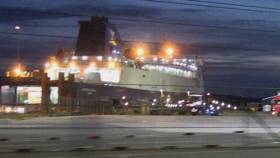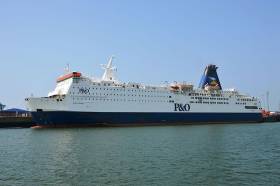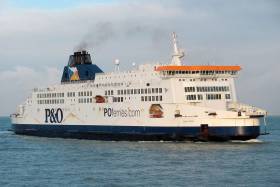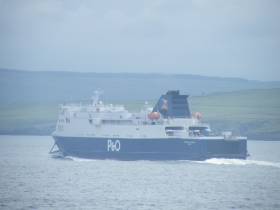Displaying items by tag: P&O Ferries
P&O Stops Transporting Calves Following BBC Investigation
#FerryNews - A North Channel ferry operator has said that it will stop carrying calves to Europe after animal welfare concerns were raised by a BBC Scotland investigation.
According to BBC News Scotland, P&O said it was ending the practice with immediate effect following the broadcast on Monday of "Disclosure: The Dark Side of Dairy".
The Scottish government said it was concerned at P&O's reaction.
NFU Scotland said it was a "disappointing" decision and described the documentary as "sensationalised".
About 5,000 calves were shipped to Europe last year from Scotland.
Campaigners claim the long journey is harmful but the industry said the alternative was shooting them at birth.
Male calves are surplus to requirements on dairy farms.
Disclosure: The Dark Side of Dairy was broadcast on BBC One Scotland on 10 September and is available on the BBC iplayer
The Disclosure team learned that calves were being exported via the port of Cairnryan in Dumfries and Galloway.
For much more on the story, click here including a link to the television investigation.
#FerryNews - Stena RoRo's charter of a vessel to P&O Ferries Dublin-Liverpool route ended at the weekend following the return of European Endeavour fresh from annual refit, writes Jehan Ashmore.
The charter of Stena Carrier to rivals, P&O was expected to terminate tomorrow, however the ro-ro freight ferry Stena Carrier completed duties earlier with a passage from Liverpool to Dublin on Sunday morning. Following discharging of vehicles, the ship proceeded to anchor in Dublin Bay also that morning (and remains so off Dun Laoghaire Harbour). Afloat awaits the next charter possibly on the North Channel?
Also on Sunday, as alluded P&O's European Endeavour, the largest of three ferries on the Liverpool route, arrived into Dublin Bay fresh from overhaul carried out at A&P Falmouth, Cornwall.
Upon arrival in Dublin Port, European Endeavour, remained in port for a scheduled Sunday layover. A first post-refit sailing departed yesterday albeit some two hours late. The returning sailing from Liverpool in comparison arrived on time to Dublin this morning. Several hours later at 15.00 the ferry departed on schedule with an arrival on Merseyside tonight at around 23.00.
Afloat will have more on the 24,046 gross tonnage, European Endeavour, in the meantime, the focus remains on Stena Carrier which in February provided a replacement vessel out of Rosslare. On that occasion, Stena Line required the services of the charter company, part of the Stena Sphere of companies, that is based in Gothenburg. The west Swedish city is where ferry company is also located.
Some principle characteristics of Stena Carrier (below) of the '4runner' class built. Among them, leadship Stena Forerunner which operates the ferry division's North Sea route: Harwich-Rotterdam (where CLdN's ro-ro recently christened Celine calls to as part of an Ireland-Belgium-UK-Netherlands route diagram).
Stena Carrier
Flag: Denmark
Port of Registry: Frederikshavn
Built: 2004
Gross Tonnage: 21,171
Deadweight: 11,783
Drivers: 12
Lane meters: 2,715
Length Overall: 182.77m
Breath Extreme: 25.50m
Draught: 6.10m
As alluded above the stint on Stena Line's Rosslare-Cherbourg service saw Stena Carrier continue in a freight-only mode (notably with livestock, estimated to be 35,000 cattle) while ropax Stena Horizon was routinely drydocked.
At that stage no passenger services were operating between the countries, except for Irish Ferries ropax Epsilon on the Dublin-Cherbourg route.
There is much anticipation of newbuild cruiseferry, W.B. Yeats onto the capital-continental connection. The 55,000 gross tonnage cruiseferry is encountering delays at the German yard of FSG, Flensburg and is not expected to enter service until late July as widely reported in the media.
#FerryNews - A Louth based events company is riding on crest of a wave after being hand-picked to work in partnership with P&O Ferries on an exciting new venture.
As the Louth Leader reports the company First Media will be working alongside the ferry firm who will be offering an unique venue for events on board P&O’s very own Pride of Hull and Pride of Rotterdam ferries. The sisters Afloat adds are among the largest ferries operating out of the UK. They serve the North Sea service connecting Hull and the giant Dutch port.
Whether you’re looking for a place to host a corporate event, training day or meetings, First Media is all aboard to provide the event management, design, and technical support.
Freddie King, business development manager at First Media said: “This is a very exciting new venture for us and we are looking forward to working with the P&O team.
To read more from the local newspaper click here.
Afloat also adds that P&O operate a second route on the North Sea, Hull-Zeebrugge in Belgium. Last month the ferry firm commented that they are “always looking for new opportunities” of opening a new Scotland-Scandinavian service.
Currently the only ferry link (albeit freight-only) between the UK and Europe is from Rosyth, Scotland to Zeebrugge. This route is run by DFDS.
#FerryNews - The highest volume of freight traffic in six years was carried on P&O Ferries Larne-Cairnryan service during 2017.
The ferry and logistics company, which operates between Northern Ireland and Scotland, carried 210,533 lorries and trailers on its ships during the last 12 months. The figure represents a 1.3 per cent increase on 2016 and is the best result since 2011.
P&O Ferries operates seven sailings a day between Larne and Cairnryan. The service on the North Channel is operated by the 22,000 ton sister ships European Highlander and European Causeway. The pair provide a bridge for goods being transported between Northern Ireland and the Republic of Ireland and Britain, and also on to the continent via P&O Ferries' connecting services from Dover, Tilbury, Hull and Teesport.
Neal Mernock, P&O Ferries' Sector Director for the Irish Sea, said: "These outstanding volumes illustrate the vital importance of our service to the thousands of businesses and millions of consumers who rely on the efficient and reliable transportation of goods across the Irish Sea."
"Larne is fast establishing itself as the gateway of choice for anyone exporting to or from Ireland, thanks to its outstanding connectivity via road and rail, and also the fact that it is nine miles closer to Scotland than the port at Belfast."
"The reliability of our service was exemplified in the spring when we brought one of our English Channel ferries, European Seaway, to cover the route while the other two ships went into dry dock for annual maintenance. The feedback from our customers was that they hadn't noticed any difference, which is the ultimate compliment."
In 2017 P&O Ferries saw strong volumes of agricultural and dairy produce, building materials, consumer goods, machinery, peat and household coal being transported on its two Irish Sea crossings, Larne-Cairnryan and Dublin-Liverpool, see Afloat's related coverage.
P&O Ferries is a leading pan-European ferry and logistics company, sailing 27,000 times a year on eight major routes between Britain, France, Northern Ireland, the Republic of Ireland, The Netherlands and Belgium. It operates more than 20 vessels which carry 10 million passengers and 2.2 million freight units annually.
Together with its logistics division, P&O Ferrymasters, the company also operates integrated road and rail links to countries across the continent including Italy, Poland, Germany, Spain and Romania. P&O Ferrymasters also owns a rail terminal in the Romanian city of Oradea, which facilitates the onward movement of goods to Britain from Asian countries via the Silk Road.
Afloat adds the operator is also examining opening a North Sea service linking Scotland and Scandinavia.
#FerryNews - According to the Edinburgh News, a ferry company has said it is willing to enter talks with the Scottish Government about a new ferry route between Scotland and Scandinavia.
P&O Ferries said it was “always looking for new opportunities” after SNP backbench MSP Angus MacDonald urged Transport Minister Humza Yousaf to call a summit with ferry operators to explore the potential for a new service between Scotland and Norway, Denmark or Sweden.
Rosyth’s freight-only ferry to Zeebrugge is currently the country’s only sea link to Europe. But a new passenger ferry to Scandinavia is seen as an opportunity to boost exports as well as tourism.
Mr MacDonald said a new ferry link could be “incredibly beneficial” to Scotland and he hoped a meeting with ferry operators could be arranged “ahead of the potential damage to our tourism sector from the impact of Brexit”.
A spokesman for P&O said: “We are always looking for new opportunities and would be happy to sit down with the relevant parties to discuss a route between Scotland and Scandinavia.”
There were more than 15 million visits to the UK from Scandinavia between 2011 and 2016, contributing nearly £8.5 billion to the UK economy. Spending by Danish visitors alone rose by 30 per cent over the five years.
In 2016, Sweden, Denmark and Norway ranked 14th, 15th and 16th for the number of visitors coming to the UK. Mr MacDonald said: “Surely it makes sense to give people another option of how to travel across the North Sea, to ensure our economy continue to benefit from tourists?”
The ferry route between Rosyth and the Belgian port of Zeebrugge opened in 2002, but the passenger service ended in 2010 and it has since been freight-only.
Mr MacDonald said the last ferry link from the UK to Scandinavia ended in 2014 which Afloat previously reported on was DFDS Seaways Harwich-Esbjerg service.
To read more on this story, click here and Afloat's piece on P&O's 180th anniversary which was marked last year.
#FerryFestive - An Irish Ferries cruiseferry on the French route based out of Rosslare returned yesterday prior to making a repositioning voyage to Dublin Port this morning in preparation of the busy festive season, writes Jehan Ashmore.
Cruiseferry, Oscar Wilde had completed a Cherbourg-Rosslare crossing. This was followed by the 1,400 passenger/700 car ferry transferring to the Irish capital to begin sailings on the core Irish Sea central coridoor route to Holyhead.
Sailings by Oscar Wilde on the French route have been suspended so to enable firstly the above mentioned capacity increased on the premier UK-Ireland route. In addition the absence of the ferry is to permit annual winter dry-docking of the 1987 built cruiseferry that is scheduled to return to the French service in February 2018.
As of late this morning Oscar Wilde made a first crossing to Holyhead and is due to return to Dublin this afternoon. Also running services to cope with the inward bound influx of seasonal passengers on the Wales-Ireland link are flagship cruiseferry Ulysses, fast-craft Jonathan Swift and ropax ferry Epsilon.
The chartered-in Epsilon, will operate Ireland-France sailings during the absence of Oscar Wilde from Wexford based sailings in 2017, but take heed of the following next scheduled sailings and ports used in both directions.
Afloat can confirm the next outward sailing to the continent is Dublin-Cherbourg and will be after Christmas, on Wednesday 27th December. The next inbound sailing to Ireland will however call instead to Rosslare, arriving on Friday 29th December. For further subsequent sailings details consult Irish Ferries through this link.
Rivals, Stena Line are expected to transport 65,000 passengers over the festive period also on their service between Holyhead-Dublin and on the St. Georges Channel link of Fishguard to Rosslare.
Information on Irish Sea routes, sailing dates, crossing times and more click here for Irish Ferries and for those travelling with Stena Line click here. From this webpage there are also links to their Cherbourg-Rosslare service.
For those travelling on P&O Ferries click this link, noting the weatherline applies to both routes: Liverpool-Dublin and Cairnryan-Larne.
In addition should there be any ferry travel delays, disruptions and cancellations, they are included on the AA’s Roadwatch newsroom here.
English Channel Ferry Runs Aground In Calais
#FerryNews - An English Channel ferry with more than 200 passengers on board has run aground at Calais, according to the Guardian.
Local officials in the French port town report that there were no injuries when P&O’s Pride of Kent grounded on what is likely a sand bank in the harbour when attempting to depart for Dover amid severe weather this afternoon (Sunday 10 December).
The ferry is said to be “stable” and it is hoped that passengers can be transferred to another vessel today.
Freight Figures 'Highest' Boost for Port of Larne
#ferry - The highest number of lorries and trailers travelling on P&O Ferries between Larne and Cairnryan was reached in the third quarter of the year than it has in any Q3 since 2011.
As the News Letter writes the ferry company carried 53,305 lorries and trailers on its ships in the months of July, August and September - a 3.3 per cent increase on the same quarter last year.
Neal Mernock, P&O Ferries Sector director on the Irish Sea, said: “We are delighted that more and more freight customers are experiencing for themselves the benefits of transporting goods between Northern Ireland and Britain with us.
“Our port at Larne is fast becoming the gateway of choice for anyone exporting to or from Ireland. It has outstanding connections via rail and road, especially after the upgrading of the A8 dual carriageway, and is nine miles closer to Scotland than the port at Belfast.”
P&O Ferries operates seven sailings a day between Larne and Cairnryan using two 21,000 ton sister vessels, European Causeway and European Highlander. The regular daily service, the company notes, provides a bridge for goods being transported between Northern Ireland and the Republic of Ireland to Britain, and also on to the continent via its connecting services from Dover, Tilbury, Hull and Teesport.
For more on this story, click here.
#Charter -A Maltese flagged Greek owned vehicle-carrier only vessel is on charter to an Irish Sea ferry operator while its ships take refit dry-docking turns in the UK, writes Jehan Ashmore.
The chartered-in Neptune Aegli can handle 1,800 cars or 1,550 lane metres of truck/trailers has begun a first sailing today for P&O Ferries. This involved an afternoon crossing from Dublin to Liverpool.
Neptune Lines operates a fleet of 16 Pure Car & Truck Vehicle Carriers (PCTC) from which Neptune Aegli joins P&O’s European Endeavour and ropax Norbay. Noting sister, Norbank this morning entered a dry dock at Cammell Laird, Birkenhead. The shipyard and marine engineering facility located on the Wirral Peninsula is opposite to Liverpool Docks.
It is a year ago when Afloat reported on the charter to P&O of Neptune Aegli. On this current charter, the 2002 built PCTC had docked in Dublin yesterday having assisted P&O operations on the North Sea. This saw the ship provide freight support relief duties for Hull-Zeebrugge ferries sisters, Pride of York and Pride of Bruges that underwent multi-million career-extension refits.
The annual refits of the North Sea 32,000 tonnes sisters took place in Gdansk, Poland, where work on the near 900 passenger each cruiseferry involved overhauls of shops, catering experience outlets and cabins and bars will now have hotspot wi-fi. In addition the extensive upgrade was carried out throughout facilities for freight customers on the UK-Belgium route.
Pride of York when launched from Govan Shipbuilders on the Clyde as Norsea in 1986 was the largest ever passenger ship built in the UK since Cunard Line’s Queen Elizabeth dating to 1969.
The famous trans-Atlantic ocean liner had too been built on the banks of the Clyde but from the John Brown yard.
P&O Handle Highest Freight Volumes on North Channel Service Since 2011
#FreightVolumes - Operator P&O Ferries has announced that it handled the highest volume of freight in five years on its Larne-Cairnryan service in 2016.
The ferry and logistics company's route on the North Channel linking Northern Ireland and Scotland handled 206,700 freight units on the route during the last 12 months. This figure represents a 7.5 per cent increase on the previous year (192,200 units).
In a further indicator of the reliability of P&O Ferries' service, 2016 was the first ever year in which none of the 4,774 sailings scheduled from the port of Larne was cancelled, with 97 per cent of departures within ten minutes of their published time.
P&O Ferries operates seven sailings a day between Larne and Cairnryan in Scotland, a two hour service which is the shortest crossing of any operator on the North Channel. The regular daily service provides a bridge for goods being transported between Northern Ireland and the Republic of Ireland and Britain, and also on to the continent via its connecting services from Dover, Tilbury, Hull and Teesport.
Neal Mernock, P&O Ferries' Director responsible for the Irish Sea, said: "This highly encouraging performance shows that the economy of Northern Ireland is continuing to grow, notwithstanding the uncertainty heralded by the Brexit vote in June. We invested £500,000 last year in our two purpose built ferries on the route, the European Highlander and European Causeway, to upgrade facilities and passenger areas on the ships. This has already paid a dividend in terms of increasing customer satisfaction with our services."
"The frequency of sailings, short crossings, excellent reliability and the fact that the port is now only 30 minutes from Belfast by road via the newly built A2 are increasingly making Larne the gateway of choice for anyone exporting to or from Northern Ireland. We have seen particularly strong volumes of agricultural and dairy produce, household and stores goods, building materials and machinery."




































































